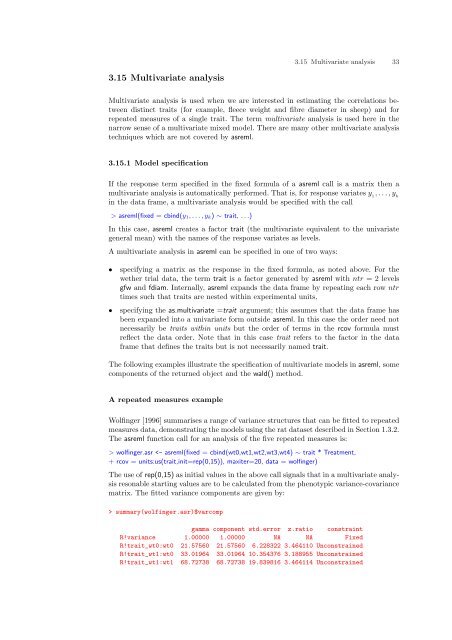ASReml-S reference manual - VSN International
ASReml-S reference manual - VSN International
ASReml-S reference manual - VSN International
- No tags were found...
You also want an ePaper? Increase the reach of your titles
YUMPU automatically turns print PDFs into web optimized ePapers that Google loves.
3.15 Multivariate analysis 333.15 Multivariate analysisMultivariate analysis is used when we are interested in estimating the correlations betweendistinct traits (for example, fleece weight and fibre diameter in sheep) and forrepeated measures of a single trait. The term multivariate analysis is used here in thenarrow sense of a multivariate mixed model. There are many other multivariate analysistechniques which are not covered by asreml.3.15.1 Model specificationIf the response term specified in the fixed formula of a asreml call is a matrix then amultivariate analysis is automatically performed. That is, for response variates y 1, . . . , y kin the data frame, a multivariate analysis would be specified with the call> asreml(fixed = cbind(y 1 , . . . , y k ) ∼ trait, . . .)In this case, asreml creates a factor trait (the multivariate equivalent to the univariategeneral mean) with the names of the response variates as levels.A multivariate analysis in asreml can be specified in one of two ways:• specifying a matrix as the response in the fixed formula, as noted above. For thewether trial data, the term trait is a factor generated by asreml with ntr = 2 levelsgfw and fdiam. Internally, asreml expands the data frame by repeating each row ntrtimes such that traits are nested within experimental units,• specifying the as.multivariate =trait argument; this assumes that the data frame hasbeen expanded into a univariate form outside asreml. In this case the order need notnecessarily be traits within units but the order of terms in the rcov formula mustreflect the data order. Note that in this case trait refers to the factor in the dataframe that defines the traits but is not necessarily named trait.The following examples illustrate the specification of multivariate models in asreml, somecomponents of the returned object and the wald() method.A repeated measures exampleWolfinger [1996] summarises a range of variance structures that can be fitted to repeatedmeasures data, demonstrating the models using the rat dataset described in Section 1.3.2.The asreml function call for an analysis of the five repeated measures is:> wolfinger.asr summary(wolfinger.asr)$varcompgamma component std.error z.ratio constraintR!variance 1.00000 1.00000 NA NA FixedR!trait_wt0:wt0 21.57560 21.57560 6.228322 3.464110 UnconstrainedR!trait_wt1:wt0 33.01964 33.01964 10.354376 3.188955 UnconstrainedR!trait_wt1:wt1 68.72738 68.72738 19.839816 3.464114 Unconstrained
















